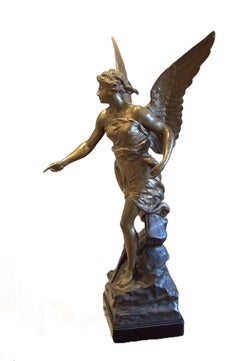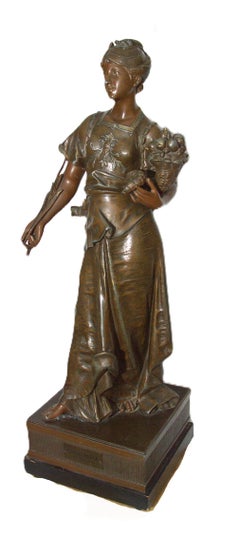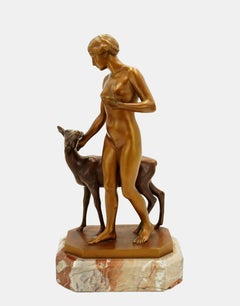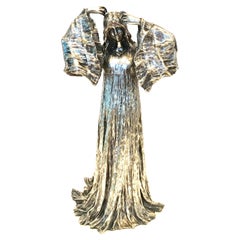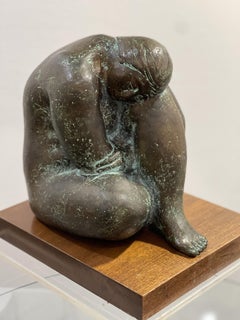Jugendstil Sculptures
to
5
8
6
1
Overall Width
to
Overall Height
to
9
11
1
1
9,801
3,488
1,493
963
463
155
140
110
90
87
65
30
9
6
19
19
18
14
12
10
4
1
1
1
1
19
19
2
1
1
1
1
20
Style: Jugendstil
Emile Louis Picault (1833-1915), 'Gloria et Fama'
Located in Berlin, DE
Bronze
67,5 cm
signed
restored Partina original
Émile Louis Picault (1833–1915) was a French sculptor known for his dynamic bronze works, often depicting mythological, allegorical,...
Category
20th Century Jugendstil Sculptures
Materials
Bronze
L'Abondance Art Nouveau
Located in Berlin, DE
Regule / a metal casting alloy
73 cm
signed
Vincent Désiré Faure de Broussé, "L'Abondance", large Art Nouveau sculpture, reguleVincent Désiré Faure de Broussé, 1834 - Paris - 19...
Category
Early 20th Century Jugendstil Sculptures
Materials
Other Medium
Eugène Laurent (1832-1898), The Beachcomber
Located in Berlin, DE
Eugène Laurent (1832-1898),
The Beachcomber
Inscribed "E. Laurent" on the base plate in the cast.
H 63 cm
Eugène Laurent studied at the École des Beaux-Arts in Paris and was awa...
Category
Early 19th Century Jugendstil Sculptures
Materials
Bronze
Seifert, Victor Heinrich. 1870 Wien - 1953 Berlin “Young athlete with slingshot”
Located in Berlin, DE
Seifert, Victor Heinrich. 1870 Vienna - 1953 Berlin
"Young Athlete with Slingshot" "David"
Large bronze, dark patinated, signed: Prof. V.H. Seifert
Height: 71.5 cm, approx. 85 cm h...
Category
Early 20th Century Jugendstil Sculptures
Materials
Bronze
Forest idyll / - Soulmate -
Located in Berlin, DE
Rudolf Kaesbach (1873 Gladbach - 1955 Berlin), Forest idyll, around 1915. Bronze, gold and golden brown patina, with cast plinth, mounted on a marble base (5 cm high), total height 36 cm, dimensions of the bronze: 31 cm (height) x 17 cm (length) x 12 cm (width). Weight 4,6 kg, signed on the plinth "R.[udolf] KAESBACH".
- a few rubbed areas, overall in excellent condition for its age
- Soulmate -
The bronze sculpture depicts a young woman in an intimate exchange with a deer that accompanies her. The animal pauses to turn toward her, while the nude beauty slows her pace to look into the deer's eyes and tenderly caress it with her hand. The woman and the deer are in inner harmony. Even though her lips remain motionless, she speaks the language of the animal with which she is deeply connected.
The golden patina, which contrasts with the more naturalistic coloring of the deer, gives the young woman the appearance of a saint, even if she cannot be identified as such. At the same time, she evokes memories of Diana, the goddess of the hunt, or a nymph. But she lacks the ferocity. In her innocent naivety, she is more like a vestal virgin, who is not at home in the solitude of the forest. And yet, the young beauty, moving unclothed in the heart of nature, looks like a priestess with her hair tied up and a carefully carried bowl on her way to a sacred grove.
In order to open up the above-mentioned associations, Kaesbach deliberately designed the female figure in such a way that she cannot be identified as a specific person. He has created an allegory of natural femininity, characteristic of Art Nouveau, in which the deer is far more than a companion animal. It displays the same gracefulness as the young woman, and the inner resemblance between the two makes the deer appear as her other self. In animal terms, it embodies her inner being, which also gives the deer an allegorical character.
About the artist
Rudolf Kaesbach studied sculpture at the Hanau Academy and worked in a bronze foundry in Paris in 1900. In order to work as an independent artist, he opened a workshop in Düsseldorf, where he cast bronzes from models he designed. In 1902 he made his debut at the German National Art Exhibition in Düsseldorf. The following year Kaesbach went to the academy in Brussels. There he was inspired by contemporary Belgian sculpture, especially the work of Constantin Meunier. He moved to Berlin, where he opened a studio in the villa district of Grunewald and devoted himself to life-size marble sculptures and the design of bronzes. From 1911, he regularly presented his works at the major art exhibitions in Berlin, as well as in Düsseldorf and Malmö. Between 1936 and 1939, he also created models for the Rosenthal porcelain factory. From 1939 to 1944, Kaesbach was represented at the major German art exhibitions in Munich.
GERMAN VERSION
Rudolf Kaesbach (1873 Gladbach - 1955 Berlin), Waldidyll, um 1915. Gold und goldbraun patinierte Bronze mit gegossener Plinthe, auf einem Marmorsockel montiert (5 cm Höhe), Gesamthöhe 36 cm, Maße der Bronze: 31 cm (Höhe) x 17 cm (Länge) x 12 cm (Breite). Gewicht 4,6 kg, auf der Plinthe mit „R.[udolf] KAESBACH“ signiert.
- vereinzele beriebene Stellen, insgesamt in einem altersgemäß ausgezeichneten Zustand
- Seelenverwandtschaft -
Die Bronzeplastik veranschaulicht eine junge Frau im innigen Austausch mit einem sie begleitenden Reh. Das Tier hält inne, um sich zu ihr hochzuwenden, während die nackte Schönheit ihren Schritt verlangsamt, um dem Reh ebenfalls in die Augen zu schauen und es zärtlich mit der Hand zu liebkosen. Die Frau und das Reh sind in einem inneren Gleichklang. Auch wenn ihre Lippen unbewegt bleiben, spricht sie die Sprache des Tieres, mit dem sie auf eine tief empfundene Weise verbunden ist.
Die im Kontrast zur naturalistischeren Einfärbung des Rehs aufstrahlende goldfarbene Patina lässt die junge Frau wie eine Heilige erscheinen, auch wenn sich nicht als Heilige identifizierbar ist. Zugleich ruft sie Erinnerungen an die Jagdgöttin Diana oder eine Nymphe hervor. Dafür fehlt ihr allerdings die Wildheit. In ihrer unschuldigen Naivität gemahnt sie vielmehr an eine Vestalin, die freilich nicht in der Waldeinsamkeit zu Hause ist. Und doch wirkt die sich unbekleidet im Herzen der Natur bewegende junge Schönheit wie eine Priesterin, die sich mit hochgebundenem Haar und der vorsichtig getragenen Schale und dem Wege zu einem Heiligen Hain befindet.
Um die gennannten Assoziationen zu eröffnen, hat Kaesbach die Frauenfigur bewusst so gestaltet, dass sie nicht als konkrete Person identifizierbar ist. Damit hat er eine für den Jugendstil charakteristische Allegorie natürlicher Weiblichkeit geschaffen, bei der das Reh weit mehr als ein Begleittier ist. Es weist dieselbe grazile Anmut wie die junge Frau auf und der innere Gleichklag der beiden lässt das Reh als ihr anderen Ich erscheinen. Es verkörpert – ins Animalische übertragen - ihr inneres Wesen, wodurch auch dem Reh ein allegorischer Charakter zukommt.
zum Künstler
Rudolf Kaesbach studierte an der Akademie Hanau Bildhauerei und war im Jahr 1900 in einer Pariser Bronzegießerei tätig. Um sich als eigenständiger Künstler betätigen zu können, eröffnete er in Düsseldorf eine Werkstatt, in der er Bronzen nach selbstentworfenen Modellen goss. 1902 debütierte er auf der Deutschen Nationalen Kunstaustellung in Düsseldorf. Im Folgejahr ging Kaesbach an die Akademie nach Brüssel. Dort wurde er von der zeitgenössischen belgischen Bildhauerei, insbesondere vom Werk Constantin Meuniers, inspiriert. Zurückgekehrt zog er nach Berlin, wo er im Villenviertel Grunewald ein Atelier eröffnete und sich neben dem Entwurf für Bronzen der lebensgroßen Marmorbildhauerei widmete. Ab 1911 präsentierte er seine Werke regelmäßig auf den Großen Berliner Kunstausstellungen, aber auch in Düsseldorf und Malmö. Zwischen 1936 und 1939 fertigte er zudem Modelle für die Porzellan-Manufaktur Rosenthal an. Von 1939 bis 1944 war...
Category
1910s Jugendstil Sculptures
Materials
Bronze
Antique bronze nude gladiator/ swordsman - Signed "Rudolf Marcuse" + "Gladenbeck
By Rudolf Marcuse
Located in Berlin, DE
Antique bronze nude gladiator/ swordsman - Signed "Rudolf Marcuse" + "Gladenbeck Berlin"
Dimensions:
Sculpture: 16.5 cm high
Base: 6.5 cm high
To...
Category
Early 20th Century Jugendstil Sculptures
Materials
Bronze
French Art Nouveau bronze by Franz Rosse 1893
Located in Berlin, DE
A late 19th-century French bronze sculpture titled "Fairy with Butterfly" by Franz Rosse (1858-1900), signed and dated "Frosse 93" on the base, depicting a semi-dressed woman floatin...
Category
1890s Jugendstil Sculptures
Materials
Bronze
Statuette femme bronze art nouveau Edouard Drouot "Souvenir" sculpture
Located in Berlin, DE
Edouard Drouot,
1859 Sommevoire – 1945 Paris
Bronze
signed
40 cm hoch
Very good state of preservation, expressive design.
Édouard Drouot (1859–1945) was a
French sculptor known for ...
Category
Early 20th Century Jugendstil Sculptures
Materials
Bronze
Eugene Laurent (French, 1832-1898) Diana the Huntress
Located in Berlin, DE
LAURENT, Eugene, (French, 1832-1898): Diana the Huntress, bronze,
64 cm high,
signed, resting on a black marble base, in an antique dress with her hunting dog.
Patinated bronze....
Category
Late 19th Century Jugendstil Sculptures
Materials
Bronze
Eutrope Bouret (1833-1906) Psyché
Located in Berlin, DE
Eutrope Bouret Bronze
Spyche
Eutrope Bouret (French, 1833-1906)
Late 19th century.
Signed on the base
Bouret (French, 1833–1906) was an important 19...
Category
19th Century Jugendstil Sculptures
Materials
Bronze
Eugene Marioton - Bronze Statue
Located in Berlin, DE
Eugène Marioton
französisch, 1854 - 1933
Muscular Nude Male Bronze Eugene Marioton - Bronze Statue, um 1900
A handsome and very fit partially draped young nude male with rippling mu...
Category
19th Century Jugendstil Sculptures
Materials
Bronze
Raoul Fançois Larche Patinated bronze figure of a woman
Located in Berlin, DE
FRANCOIS-RAOUL LARCHE 1860 SAINT-ANDRÉ-DE-CUBZAC - 1912 PARIS
Signed on the base with "RAOUL LARCHE," foundry mark "SIOT DECAUVILLE PARIS FONDEUR," and number "R 276."
Total height...
Category
Early 1900s Jugendstil Sculptures
Materials
Bronze
Mathurin Moreau (1822-1912), Diana, patinated bronze on a marble base
Located in Berlin, DE
Bronze
bronze on a marble base, H 46 - 49 cm (without - with base)
Signed on the bronze base.
bronze sculpture depicting Diana the Huntress holding a bow.
Mathurin Moreau (1822-1...
Category
1890s Jugendstil Sculptures
Materials
Bronze
Französische Bronze Emile Louis Picault „Charity-Bien Faisance“
Located in Berlin, DE
Bronze Emile Louis Picault
"Charity-Bien Faisance," a French bronze figure by Emile Louis Picault.
50 cm
Bronze signed Emile Louis Picault. With cast stamp.
Wonderful work with a ...
Category
1890s Jugendstil Sculptures
Materials
Bronze
Beautiful late 19th-century bronze sculpture by Mathurin Moreau
Located in Berlin, DE
Beautiful late 19th-century bronze sculpture by Mathurin Moreau
"YOUNG WOMAN ON A ROCK" BY MATHURIN MOREAU (1822-1912)
Young girl with a broken jug,
Bronze circa 1880/1890, France
...
Category
Late 19th Century Jugendstil Sculptures
Materials
Bronze
Louis Auguste Moreau children Bronze
Located in Berlin, DE
Bronze
54 x 23 cm
signed
Auguste Moreau (1834–1917) was a French sculptor known for his romantic and decorative style, often working in the tradition of the Belle Époque. He was p...
Category
Early 20th Century Jugendstil Sculptures
Materials
Bronze
German shepherd dog by Thomas Franois Cartier 20 20th century
Located in Berlin, DE
Bronze
signed
58x 56 cm
Thomas François Cartier, born February 21, 1879 in Marseille and died April 26, 1936 in Saint-Vallier, is an animal sculptor and French illustration.
biogr...
Category
20th Century Jugendstil Sculptures
Materials
Bronze
Emile Louis Picault (1833-1915), 'Le Penseur'
Located in Berlin, DE
Emile Louis Picault (1833-1915), 'Le Penseur', patinated bronze mounted on a marble base, H 30 - 33 cm (bronze - total)
A fantastic quality Bronze of
Emile Louis Picault
Signed o...
Category
Late 19th Century Jugendstil Sculptures
Materials
Bronze
Hebe Par Drouot Edouard Drouot (French, 1859-1945)
Located in Berlin, DE
Bronze, beautifully cast, patinated. Above a fluted round base, the figure of the Greek goddess of youth. Hébé is depicted here rising in a tight-fitting robe before an eagle, the sy...
Category
Early 20th Century Jugendstil Sculptures
Materials
Bronze
French Art Nouveau bronze JOAQUÍN ANGLÉS CAÑÉ
Located in Berlin, DE
JOAQUÍN ANGLÉS CAÑÉ (Tortosa, 1859 - Paris, 1911).
Joaquin Anglès Cañé
(born 1859 Tortosa - c. 1925)
Idyll. Original title:
Bronze, dark brown patinated. Sign.
'Idyll', a bronze sta...
Category
20th Century Jugendstil Sculptures
Materials
Bronze
Related Items
Agathon Leonard Silvered Bronze Of Marguerite
Located in Dallas, TX
Agathon Leonard (French, 1841 - 1923) Art Nouveau Silvered Bronze
A French Art Nouveau gilt bronze sculpture, "Marguerite", by Agathon Léonard of Margeruite, placing a flower in her...
Category
1890s Jugendstil Sculptures
Materials
Bronze
Mujer Agachada (Crouching Woman), 1972, (III/VI)
Located in San Francisco, CA
Felipe Castañeda
Mujer Agachada (Crouching Woman), 1972
Bronze, wood base
12 x 9.5 x 11.5 inches
Edition III/VI
Most recent owners acquired this limited-edition bronze sculpture fro...
Category
Late 20th Century Jugendstil Sculptures
Materials
Bronze
$12,000 Sale Price
20% Off
H 12 in W 9.5 in D 11.5 in
Antique French Art Nouveau Bronze Figure Statue Sculpture "Prise de Corsaire"
Located in Portland, OR
A fine antique large French Art Nouveau Bronze Figural Sculpture, titled "Prise de Corsaire" by Emmanuel Villanis (1858-1914), circa 1900.
This very...
Category
Early 1900s Jugendstil Sculptures
Materials
Bronze
$6,200
H 34 in W 11 in D 7.75 in
Leda and the Swan
Located in West Hollywood, CA
Presenting a magnificent early Art Nouveau bronze by Belgian artist Jef Lambeaux(1852-1908.)
“Leda and the Swan”, is an original Art Nouveau Bronze,...
Category
1880s Jugendstil Sculptures
Materials
Bronze
The Rape of Sabine Iconic Bronze Sculpture 1930
Located in Rome, IT
Fine Group of Sculptures in Bronze after Jean de Boulogne (Giambologna)
The torturously twisting Rape of the Sabine Women is one of the finest and most technically difficult sculpt...
Category
1920s Jugendstil Sculptures
Materials
Bronze
$7,661 Sale Price
20% Off
H 35.44 in W 8.27 in D 8.27 in
The Rape of Sabine Iconic Bronze Sculpture 1930
Located in Rome, IT
Fine Group of Sculptures in Bronze after Jean de Boulogne (Giambologna)
The torturously twisting Rape of the Sabine Women is one of the finest and most technically difficult sculpt...
Category
1920s Jugendstil Sculptures
Materials
Bronze
$6,704 Sale Price
30% Off
H 35.44 in W 8.27 in D 8.27 in
horse. 19th century bronze sculpture
Located in CORAL GABLES - MIAMI, FL
horse. 19th century bronze sculpture
measurements with the base are 37.5 x 17.5 x 31 cm
Category
Late 19th Century Jugendstil Sculptures
Materials
Bronze
Large French Terracotta Art Nouveau Sculpture "The Bacchante" Signed
Located in Pistoia, IT
"The Bacchante," an imposing terracotta group bearing the signature of Domien van den Bossche. Late 19th century.
Probably inspired by Carrier Belleuse's "The Bacchante" group of ...
Category
Late 19th Century Jugendstil Sculptures
Materials
Terracotta
$2,633
H 37.41 in W 14.57 in D 13.78 in
Eugene Marioton - Bronze Statue
Located in Berlin, DE
Eugène Marioton
französisch, 1854 - 1933
Muscular Nude Male Bronze Eugene Marioton - Bronze Statue, um 1900
A handsome and very fit partially draped young nude male with rippling mu...
Category
19th Century Jugendstil Sculptures
Materials
Bronze
"Mother and Child" Art Nouveau Bronze Sculpture Woman Carrying Harvest Green
Located in Austin, TX
20 inches tall x 11 inches wide at base.
Signed.
Numbered 6/100
A cast bronze sculpture that depicts an adult female, rural worker, mid-stride, holding a large bundle of wood on her...
Category
Early 20th Century Jugendstil Sculptures
Materials
Marble, Bronze
$1,000
H 20 in W 11 in D 11 in
Petite Femme Chiffonnèe
Located in Villafranca Di Verona, IT
Numbered and limited to 8 copies
Artwork signed
Authenticity: Sold with certificate of Authenticity
Invoice from the gallery
Sculpture: bronze, metal, bronze patina
Display: The sc...
Category
1950s Jugendstil Sculptures
Materials
Metal, Bronze
Pandora's Secret
Located in PARIS, FR
Pandora's Secret
by Maurice BOUVAL (1863-1916)
Sculpture made in bronze with a nuanced dual patina, light –and dark brown
signed on the base " M. Bouval "
old edition cast
presente...
Category
Early 1900s Jugendstil Sculptures
Materials
Bronze
Jugendstil sculptures for sale on 1stDibs.
Find a wide variety of authentic Jugendstil sculptures available for sale on 1stDibs. Works in this style were very popular during the 20th Century, but contemporary artists have continued to produce works inspired by this movement. Frequently made by artists working with Bronze, and Metal and other materials, all of these pieces for sale are unique and have attracted attention over the years. Not every interior allows for large Jugendstil sculptures, so small editions measuring 3.5 inches across are also available. Prices for sculptures made by famous or emerging artists can differ depending on medium, time period and other attributes. On 1stDibs, the price for these items starts at $880 and tops out at $149,500, while the average work sells for $75,190.
Still Thinking About These?
All Recently ViewedMore Ways To Browse
Sergio Bustamante Cat
Sterling Hare
Sterling Silver Hare
Batman Toy
Bird With Tuft
Boxing Hares Sculpture
Bronze Hummingbird
Dave Alexander
Elizabeth Fritsch
Guerra Sculpture
Herb Mignery
Hiro Ando Warrior Cats
Jules Lagae
Naked Man Sculpture
Randy Cooper Wire Mesh Sculpture
Snoopy Sculpture
Tall Wire Sculpture
Vincent Beaurin
